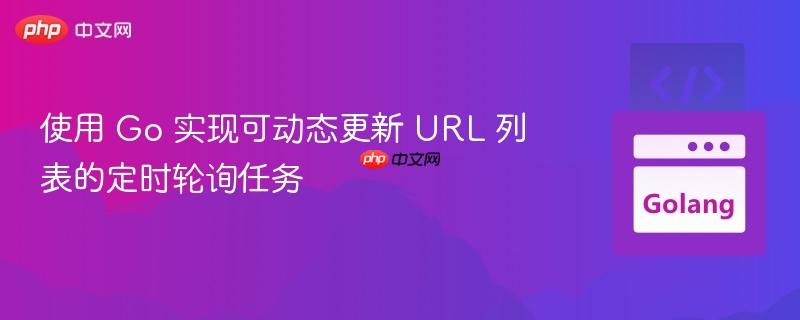
本文介绍如何使用 Go 语言实现一个定时轮询任务,该任务可以定期抓取 URL 列表的内容,并支持在运行时动态添加新的 URL 到列表中。通过使用 Go 语言的并发特性和 channel,可以安全高效地管理 URL 列表的更新,确保轮询任务始终包含最新的 URL 信息。
在 Go 语言中,并发编程是一个重要的特性。本文将介绍如何使用 Go 语言实现一个可动态更新 URL 列表的定时轮询任务。这个任务会定期抓取 URL 列表中的内容,并且允许在运行时安全地添加新的 URL 到列表中。
核心思想是使用一个 harvester 结构体来管理 URL 列表和定时器。harvester 结构体包含以下字段:
harvester 结构体还包含以下方法:
package main
import (
"fmt"
"time"
)
type harvester struct {
ticker *time.Ticker // periodic ticker
add chan string // new URL channel
urls []string // current URLs
}
func newHarvester() *harvester {
rv := &harvester{
ticker: time.NewTicker(time.Minute * 30),
add: make(chan string),
urls: []string{}, // 初始化为空切片
}
go rv.run()
return rv
}
func (h *harvester) run() {
for {
select {
case <-h.ticker.C:
// When the ticker fires, it's time to harvest
for _, u := range h.urls {
harvest(u)
}
case u := <-h.add:
// At any time (other than when we're harvesting),
// we can process a request to add a new URL
h.urls = append(h.urls, u)
fmt.Println("Added URL:", u, "Current URLs:", h.urls) // 打印当前URL列表
}
}
}
func (h *harvester) AddURL(u string) {
// Adding a new URL is as simple as tossing it onto a channel.
h.add <- u
}
func harvest(url string) {
// Download the current contents of the URL and do something with it
fmt.Println("Harvesting:", url)
// Simulate network request delay
time.Sleep(time.Second * 2)
fmt.Println("Harvested:", url)
}
func main() {
h := newHarvester()
// Add some initial URLs
h.AddURL("https://www.example.com/page1")
h.AddURL("https://www.example.com/page2")
// Add a new URL after a delay
time.Sleep(time.Minute * 1)
h.AddURL("https://www.example.com/page3")
// Keep the main function running to allow the harvester to work
time.Sleep(time.Hour * 1)
}代码解释:
运行上述代码,可以看到以下输出:
Added URL: https://www.example.com/page1 Current URLs: [https://www.example.com/page1] Added URL: https://www.example.com/page2 Current URLs: [https://www.example.com/page1 https://www.example.com/page2] Harvesting: https://www.example.com/page1 Harvested: https://www.example.com/page1 Harvesting: https://www.example.com/page2 Harvested: https://www.example.com/page2 Added URL: https://www.example.com/page3 Current URLs: [https://www.example.com/page1 https://www.example.com/page2 https://www.example.com/page3] Harvesting: https://www.example.com/page1 Harvested: https://www.example.com/page1 Harvesting: https://www.example.com/page2 Harvested: https://www.example.com/page2 Harvesting: https://www.example.com/page3 Harvested: https://www.example.com/page3
可以看到,新的 URL 在添加到列表后,会在下一次轮询时被抓取。
本文介绍了一种使用 Go 语言实现可动态更新 URL 列表的定时轮询任务的方法。通过使用 Go 语言的并发特性和 channel,可以安全高效地管理 URL 列表的更新,确保轮询任务始终包含最新的 URL 信息。这种方法可以应用于各种需要定期抓取 URL 内容的场景,例如网站监控、数据采集等。
以上就是使用 Go 实现可动态更新 URL 列表的定时轮询任务的详细内容,更多请关注php中文网其它相关文章!

每个人都需要一台速度更快、更稳定的 PC。随着时间的推移,垃圾文件、旧注册表数据和不必要的后台进程会占用资源并降低性能。幸运的是,许多工具可以让 Windows 保持平稳运行。

Copyright 2014-2025 https://www.php.cn/ All Rights Reserved | php.cn | 湘ICP备2023035733号